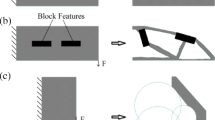Much of the knowledge that is applied in or communicated between design and manufacturing activities is primarily shape based or shape indexed. Previous attempts to acquire and organize shape knowledge have been mostly concentrated on feature recognition from solid models, group technology (GT) coding schemes, and feature-based modeling. This paper presents the development of an efficient form-feature-based modeling system, and addresses the important issue of utilizing feature information for manufacturing, which has not been extensively discussed by previous work. In this paper we first present a Euler operator-based approach for efficient and effective form-feature encoding and manipulation in a feature-based design environment. Subsequently, a hybrid representation scheme called enhanced CSG tree of feature (ECTOF), which integrates feature model with solid model in a tree structure, is discussed. A feature interference resolution methodology to maintain the correct and consistent feature information in an ECTOF is also deliberated. Finally, we present a machinability-checking module, which employs global accessibility criteria to analyze a feature's machinability on a three-axis machining center. By developing feature interference resolving and machinability testing techniques and integrating with an efficient feature-based design system, this research makes the development of an integrated feature-based design and manufacturing system possible.
Similar content being viewed by others
References
Baumgart, B. (1974) Geometric modeling for computer vision, PhD thesis, Stanford University, Stanford, CA.
Baumgart, B. (1975) A polyhedron representation for computer vision. AFIPS Conference Proceedings, 44, 589–596.
Braid, I. C. (1979) Notes on a Geometric Modeller, CAD Group Document 101, Computer Laboratory, University of Cambridge, Cambridge, UK.
Braid, I. C., Hillyard, R. and Stroud, I. (1980) Stepwise construction of polyhedra in geometric modeling, in Mathematical Methods in Computer Graphics and Design, Academic Press, London, pp. 123–141.
Bronsvoort, W. F. and Jansen, F. W. (1993) Feature modelling and conversion - key concepts to concurrent engineering. Computers in Industry, 21, 61–86.
Chiyokura, H. (1988) Solid Modelling with Design Base - Theory and Implementation, Addison-Wesley, New York.
Cunningham, J. J. and Dixon, J. R. (1988) Designing with features: the origin of features, in Proceedings of 1988 Computers in Engineering Congress, 1, ASME, pp. 237–243.
Gossard, D. C., Zuffante, R. P. and Sakurai, H. (1988) Representing dimensions, tolerances, and features in MCAE systems. IEEE CG&A, March, pp 51–59.
Henderson, M. R. and Anderson, D. C. (1984) Computer recognition and extraction of form features: a CAD/CAM link. Computers in Industry, 5, 329–339.
Houtzeel, A. (1975) MICLASS: a classification system based on group technology, Society of Manufacturing Engineers Working Paper No. MS 75-721.
Hummel, K. E. (1989) Coupling rule-based and object-oriented programming for the classification of machined features, in Proceedings 1989 ASME International Computers in Engineering Conference and Exhibition, Anaheim, CA, 1, pp. 409–418.
Joshi, S. and Chang, T. C. (1988) Graph-based heuristics for recognition of machined features from a 3D solid model. Computer Aided Design, 20, 58–66.
Keen, A. (1993) A non-manifold shape representation, PhD dissertation, Texas A&M University, College Station, TX.
Mäntylä, M. (1988) An Introduction to Solid Modeling, Computer Science Press, Inc., Rockville, MD.
Marefat, M. and Kashyap, R. L. (1990) Geometric reasoning for recognition of three-dimensional object features. IEEE Transactions on Pattern Analysis and Machine Intelligence, 12(10), 949–965.
Mayer, R. J., Su, C. J., Sun, T. L. and Wysk, R. A. (1994) ECTOF: a feature representation technique for concurrent engineering applications. Journal of Design and Manufacturing, 4, 49–65.
NIST (1992) Industrial Automation Systems - Exchange of Product Model Data - Representation and Format Description. Part 48: General Resource: Form Features, National Institute of Standards and Technology, Gaithersburg, MD.
Nnaji, B. O. and Liu, H. C. (1990) Feature reasoning for automatic robotics assembly and machining in polyhedral representation. International Journal of Production Research, 28, 517–540.
Optiz, H. (1970) A Classification System to Describe Work-Pieces, Pergamon Press, Oxford, UK.
Pratt, M. J. (1988) Synthesis of an optimal approach to form feature modelling, in Proceedings 1988 ASME International Computers in Engineering Conference and Exhibition, ASME, New York, 1, pp. 263–274.
Preparata, F. P. and Shamos, M. I. (1985) Computational Geometry, Springer-Verlag, New York.
Requicha, A. A. G. (1980) Representation for rigid solids: theory, method and systems. ACM Computing Surveys, 12, 437–464.
Roller, D. (1989) Design by features: an approach to high level shape manipulations. Computers in Industry, 12, 185–191.
Sakurai, H. and Gossard, D. C. (1990) Recognizing shape features in solid models. IEEE CG&A, September, pp 22–32.
Salomons, O. W., van Houten, F. J. A. M. and Kals, H. J. J. (1993) Review of research in feature-based design. Journal of Manufacturing Systems, 12(2), 113–132.
Shah, J. J. and Roger, M. T. (1988) Expert form feature modelling shell. Computer Aided Design, 20, 515–524.
Shah, J. J. (1991) Assessment of features technology. Computer Aided Design, 23(5), 331–343.
Su, C. J. and Mukerjee, A. (1991) Automated machinability checking for CAD/CAM. IEEE Transactions on Robotics and Automation, 7(5), 691–699.
Su, C. J., Mayer, R. J., Sun, T. L. and Wysk, R. A. (1994) A three phase method for feature interaction resolution. Journal of Design and Manufacturing, 4, 153–166.
Sun, T. L. (1992) An interference solving methodology for form feature modeling, MS Thesis, Texas A&M University, College Station, TX.
Vandenbrande, J. H. and Requicha, A. A. G. (1993) Spatial reasoning for the automatic recognition of machinable features in solid models. IEEE Transactions on Pattern Analysis and Machine Intelligence, 15(12), 1269–1285.
Wu, C. N. (1992) Method for form feature creation and modification: an Euler operators' approach, MS Thesis, Texas A&M University, College Station, TX.
Author information
Authors and Affiliations
Rights and permissions
About this article
Cite this article
Su, CJ., Sun, TL., Wu, CN. et al. An integrated form-feature-based design system for manufacturing. J Intell Manuf 6, 277–290 (1995). https://doi.org/10.1007/BF00124673
Issue Date:
DOI: https://doi.org/10.1007/BF00124673




